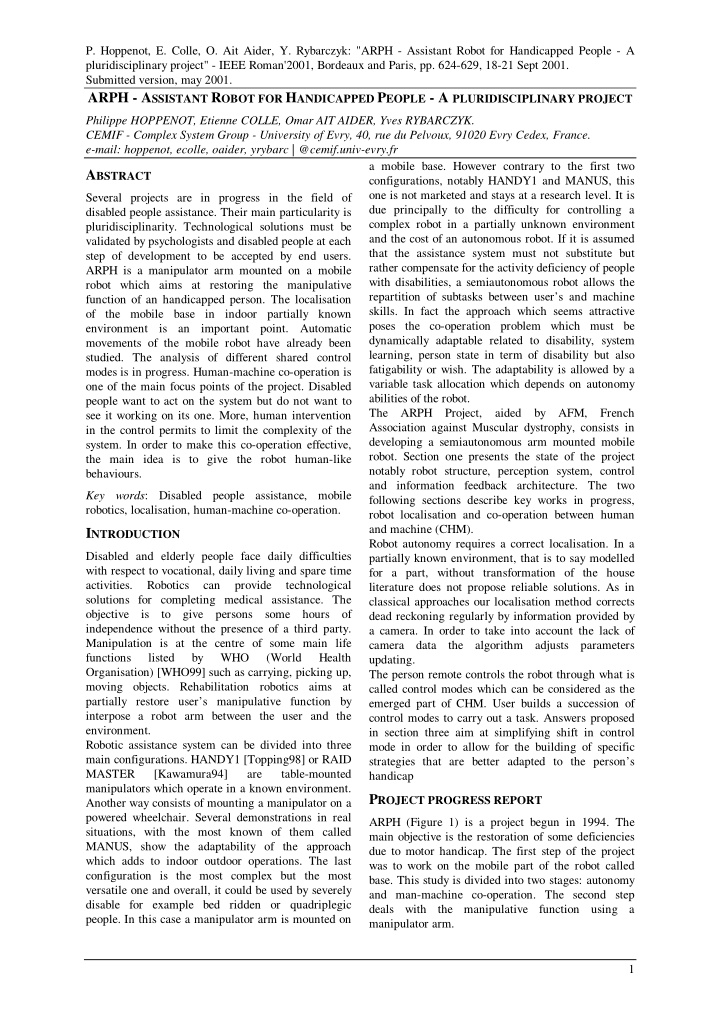



P. Hoppenot, E. Colle, O. Ait Aider, Y. Rybarczyk: "ARPH - Assistant Robot for Handicapped People - A pluridisciplinary project" - IEEE Roman'2001, Bordeaux and Paris, pp. 624-629, 18-21 Sept 2001. Submitted version, may 2001. ARPH - A SSISTANT R OBOT FOR H ANDICAPPED P EOPLE - A PLURIDISCIPLINARY PROJECT Philippe HOPPENOT, Etienne COLLE, Omar AIT AIDER, Yves RYBARCZYK. CEMIF - Complex System Group - University of Evry, 40, rue du Pelvoux, 91020 Evry Cedex, France. e-mail: hoppenot, ecolle, oaider, yrybarc | @cemif.univ-evry.fr a mobile base. However contrary to the first two A BSTRACT configurations, notably HANDY1 and MANUS, this one is not marketed and stays at a research level. It is Several projects are in progress in the field of due principally to the difficulty for controlling a disabled people assistance. Their main particularity is complex robot in a partially unknown environment pluridisciplinarity. Technological solutions must be and the cost of an autonomous robot. If it is assumed validated by psychologists and disabled people at each that the assistance system must not substitute but step of development to be accepted by end users. rather compensate for the activity deficiency of people ARPH is a manipulator arm mounted on a mobile with disabilities, a semiautonomous robot allows the robot which aims at restoring the manipulative repartition of subtasks between user’s and machine function of an handicapped person. The localisation skills. In fact the approach which seems attractive of the mobile base in indoor partially known poses the co-operation problem which must be environment is an important point. Automatic dynamically adaptable related to disability, system movements of the mobile robot have already been learning, person state in term of disability but also studied. The analysis of different shared control fatigability or wish. The adaptability is allowed by a modes is in progress. Human-machine co-operation is variable task allocation which depends on autonomy one of the main focus points of the project. Disabled abilities of the robot. people want to act on the system but do not want to The ARPH Project, aided by AFM, French see it working on its one. More, human intervention Association against Muscular dystrophy, consists in in the control permits to limit the complexity of the developing a semiautonomous arm mounted mobile system. In order to make this co-operation effective, robot. Section one presents the state of the project the main idea is to give the robot human-like notably robot structure, perception system, control behaviours. and information feedback architecture. The two Key words : Disabled people assistance, mobile following sections describe key works in progress, robotics, localisation, human-machine co-operation. robot localisation and co-operation between human I NTRODUCTION and machine (CHM). Robot autonomy requires a correct localisation. In a Disabled and elderly people face daily difficulties partially known environment, that is to say modelled with respect to vocational, daily living and spare time for a part, without transformation of the house activities. Robotics can provide technological literature does not propose reliable solutions. As in solutions for completing medical assistance. The classical approaches our localisation method corrects objective is to give persons some hours of dead reckoning regularly by information provided by independence without the presence of a third party. a camera. In order to take into account the lack of Manipulation is at the centre of some main life camera data the algorithm adjusts parameters functions listed by WHO (World Health updating. Organisation) [WHO99] such as carrying, picking up, The person remote controls the robot through what is moving objects. Rehabilitation robotics aims at called control modes which can be considered as the partially restore user’s manipulative function by emerged part of CHM. User builds a succession of interpose a robot arm between the user and the control modes to carry out a task. Answers proposed environment. in section three aim at simplifying shift in control Robotic assistance system can be divided into three mode in order to allow for the building of specific main configurations. HANDY1 [Topping98] or RAID strategies that are better adapted to the person’s MASTER [Kawamura94] are table-mounted handicap manipulators which operate in a known environment. P ROJECT PROGRESS REPORT Another way consists of mounting a manipulator on a powered wheelchair. Several demonstrations in real ARPH (Figure 1) is a project begun in 1994. The situations, with the most known of them called main objective is the restoration of some deficiencies MANUS, show the adaptability of the approach due to motor handicap. The first step of the project which adds to indoor outdoor operations. The last was to work on the mobile part of the robot called configuration is the most complex but the most base. This study is divided into two stages: autonomy versatile one and overall, it could be used by severely and man-machine co-operation. The second step disable for example bed ridden or quadriplegic deals with the manipulative function using a people. In this case a manipulator arm is mounted on manipulator arm. 1
Recommend
More recommend